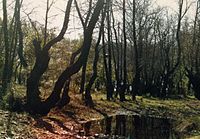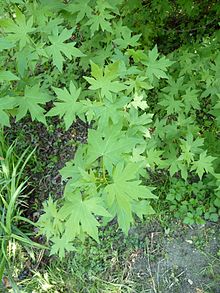- Liquidambar orientalis
-
Oriental Sweetgum 
19th century illustration of Oriental Sweetgum Scientific classification Kingdom: Plantae (unranked): Angiosperms (unranked): Eudicots (unranked): Core eudicots Order: Saxifragales Family: Altingiaceae Genus: Liquidambar Species: L. orientalis Binomial name Liquidambar orientalis
L.Liquidambar orientalis, commonly known as oriental sweetgum or Turkish sweetgum,[1] is a deciduous tree in the genus ''Liquidambar'', native to the eastern Mediterranean region, that occurs as pure stands mainly in the flood plains of southwestern Turkey and on the Greek island of Rhodes.
Contents
Biotope
The forests of this Tertiary relict endemic taxon are found notably within a specially protected area between Dalyan and Köyceğiz in Muğla Province, where a 286 hectares zone is set aside as a nature reserve and arboretum for the preservation of the species. A large stand also surrounds Marmaris. These two areas are the better known oriental sweetgum forests due to their respective regions also being prominent centers of tourism, although a big population covering nearly 100 hectares is also found in an inland region within Aydın Province extending between Çine, Köşk and Umurlu districts. Yet another sweetgum forest area (88.5 hectares) under protection is situated in Burdur's depending district of Bucak alongside Karacaören dam reservoir on the road to Antalya.[2] The trees are also found locally in Denizli's depending districts of Beyağaç and Tavas.[3] The total area of pure sweetgum forests in Turkey covers 1,348 hectares, all in the southwestern regions of the country. The present-day extension corresponds to a marked decrease since the 1940s level of 6000-7000 hectares, although the protective measures and infrastructure in place since the 1980s helped stop loss of stands and led to slight improvements.
Etymology
The name in Turkish for the particular species is Günlük ağacı, while the trees of the genus as a whole are called Sığala ağacı, a name also used in sole reference to oriental sweeetgum itself. Günlük ağacı means “a frankincense/myrrh tree [ağaç]” in which the first element is of unknown origin, whereas sığala refers to “a boggy place”.
Production and medicinal uses
The extraction of its sap and the production of an oil based thereof (sığala yağı), as well as exports of these products, play an important role in the local economy. The recolt of the sap and the preparation of the oil involve quite toilsome tasks lasting from May to November and consisting of several separate phases. There is a danger for the present generation of master oil makers not being replaced in near future.[4]
In English, this oil is known under several names, shortly as Storax to englobe all sweetgum oils, or as Styrax Levant, Asiatic Storax, Balsam Storax, Liquid Storax, Oriental Sweetgum Oil, or Turkish Sweetgum Oil. Diluted with a suitable carrier oil, it is used externally in traditional medicine for abrasions, anxiety, bronchitis, catarrh, coughs, cuts, ringworm, scabies, stress-related conditions and wounds.[5] It is a different product than the benzoin resin produced from tropical trees in the genus Styrax.
The hydrocarbon styrene is named for Levant styrax from this species (Liquidambar orientalis), from which it was first isolated,[citation needed] and not for the genus Styrax itself; industrially produced styrene is now used to produce polystyrene plastics, including Styrofoam.
Prospects
 A grove of Turkish sweetgum trees in south-west Turkey, between Marmaris and Dalaman.
A grove of Turkish sweetgum trees in south-west Turkey, between Marmaris and Dalaman.
The status of and developments regarding the protection of Turkish Sweetgum continues to occupy local and national environmental agenda at a critical level in Turkey. Among the main causes for the loss of sweetgum forests was the cutting and felling of trees for opening new fields for agriculture, as well as the construction of three separate dams at localities which precisely corresponded to important habitats for the species. As such, Liquidambar orientalis holds an important position in Turkey's biodiversity and among endemic species, is one of its best-known symbols.
References
- (full text) Melis Or - Zeki Kaya (2007). Identification of Turkish Sweetgum (Liquidambar Orientalis) varieties by studying ten regions of Chloroplast DNA, p.166 In Proceedings of the IUFRO Division 2 Joint Conference: Low Input Breeding and Conservation of Forest Genetic Resources. Akdeniz University.
- (full text) A. Çelik (Pamukkale University), A. Güvensen, Ö. Seçmen, M. Öztürk (Ege University) (1997). Studies on the Ecology of Liquidambar Orientalis Mill. distributed on Aydın Mountains p. 165. Food and Agriculture Organization.
- (full text) Yahya Ayaşlıgil, Adnan Uzun (İstanbul University) (1997). The Yunus Emre Arboretum as a conservation tool for a relict Liquidambar Orientalis wood in the specially protected area of Dalyan - Köyceğiz (S.W. Turkey) p. 165. Food and Agriculture Organization.
- full text, p. 3 Levent Keskin, (Ministry of Environment), Eyüp Yüksel (Authority for the Protection of Special Areas)
Footnotes
- ^ Todd Lasseigne. Friends of the Arboretum Newsletter Fall 2000-Winter 2001 "Horticulture". North Carolina State University J.C. Raulston Arboretum. http://www.ncsu.edu/jcraulstonarboretum/publications/newsletters/12-fall_winter/newsletter.html Friends of the Arboretum Newsletter Fall 2000-Winter 2001. Retrieved 2007-05-18.
- ^ Kargı Sweetgum Forest "Bucak Kargı village Protected Natural Area map and information" (in Turkish). Burdur General Directorate of Environment and Forestry. http://www.burdur-cevreorman.gov.tr/DKMP/kargisiglaormani Kargı Sweetgum Forest.
- ^ Rasim Çetiner. Beyağaç "Flora of Beyağaç and its surrounding region" (in Turkish). Karadeniz Technical University. http://www.rasimcetiner.com/Bilginotlar/Diger/Beyagac.pdf Beyağaç.
- ^ Atlas magazine April 2006 edition "Son Amber (The last amber)" (in Turkish). Atlas (magazine). http://www.kesfetmekicinbak.com/atlaslar/dergi/01986 Atlas magazine April 2006 edition.
- ^ Styrax - Levant "Guide to Essential Oils". http://12121.hostinguk.com/Guide%20Oils.htm Styrax - Levant.
Categories:- Saxifragales
- Flora of Turkey
- Medicinal plants
- Muğla
- Aydın
- Denizli
- Burdur
Wikimedia Foundation. 2010.

